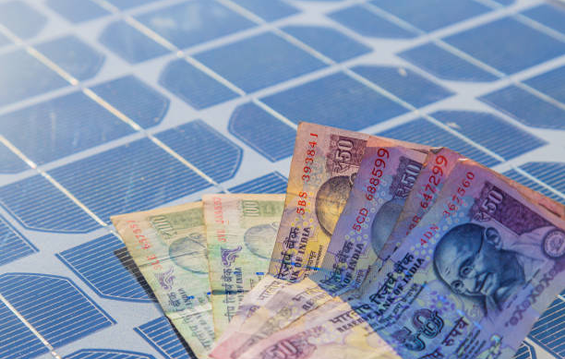If you are planning to go solar it is important that you are aware of the options available for you. One of the best options that you can check out is a hybrid solar system that fulfils your electricity requirements 24 x 7. It is ‘hybrid’ because it shares the features of both on-grid and off-grid solar systems.
What is the Hybrid Solar System?
A hybrid solar system stays connected to the grid and has a battery backup at the same time. The battery stores excess power first and then exports it to the grid. So, the hybrid has the capabilities of both on-grid and off-grid solar systems.
The hybrid solar system absorbs the sun’s energy and converts it to direct current which then goes through an inverter to generate electricity in a usable form, i.e. alternative current (AC). The electricity goes through your net meter to your appliances.
The excess electricity goes to the batteries like an off-grid system for future usage. When batteries are full, the excess electricity reaches to the utility grid after passing through the net meter.
Benefits of Installing Hybrid Solar System?
You will get the following benefits by installing a hybrid solar panel system:
- Power during Blackouts: Using hybrid solar system, you can store excess solar energy and use it during power cuts. So, you will get power 24×7.
- Saving Electricity Bill: You can generate up to 12 units of electricity with a hybrid solar system of 3KWp. This will save your electricity bill by up to Rs.2880 (considering the power tariff is Rs.8/unit)
- Import of Electricity: In case the power supply from the hybrid solar system is insufficient, you can import AC electricity directly from the grid. The net meter will calculate your import and export of electricity.
How Does Hybrid Solar System Work?
Hybrid solar solution is a little bit more complicated than on-grid or off-grid solar system. This is because it keeps track of not just electricity flowing between panels and grid but also the charge of solar batteries as well as the flow of energy.
Here is a step-by-step guide as to how a hybrid solar system work:
Step 1: Solar Energy Absorption
During daytime, the solar panel absorbs the energy of the sun. The solar panels transform this energy into direct electricity (DC).
Step 2: Energy Conversion from DC to AC
After this, DC travels through wires and enters the solar inverter. Here DC electricity is converted into AC so that it runs home appliances.
Step 3: Solar Energy Channelling
First, the electricity generated through the hybrid solar system runs appliances used at that time. Then, the excess energy gets stored in the batteries for use on a later stage when the hybrid solar system do not produce energy. After the battery is charged fully, the solar AC energy passes to the power grid.
Step 4: Energy Import/Export
At night and during power cuts, the hybrid solar system supplies power from the battery backup. When the stored electricity in the batteries is over, your system can import electricity from the utility grid.
Step 5: Net Meter Reading
The net meter of your household hybrid solar system calculates the amount of power you import and export in a month. The power distributor calculates your bill then by considering your electricity import/export.
What are the Components of a Hybrid Solar System?
Due to its connection with multiple power sources, hybrid solar systems comparatively have more components. Here is a list of all the components present in a hybrid solar system:
There are different types of solar panels available in the market, all having different efficiency and lifespan. The main types are Mono PERC, Poly PERC, TOPCon, HJT and thin-film.
For hybrid solar system with 1 KW to 6 KW capacity, you need to use a single-phase ACDB box that has a live wire and a neutral wire. For solar system with a 6 KW+ capacity, you will need a three-phase junction that has 3 live wires and 1 neutral wire. This type of wiring helps in proper management of higher voltage of system.
MPPT or Maximum Power Point Tracking and PWM or Pulse Width Modulation help in managing the current. They further help in protecting components of the solar system from overcharging, undercharging as well as sudden voltage surges.
Generally, batteries with a C rating are best for hybrid solar systems. When your solar panels do not generate sufficient amount of power for home appliances, the battery supplies power to your house and manages the power outage for the time being.
Advantages of Hybrid Solar System
There are many advantages of installing a hybrid solar system for meeting both residential and commercial requirements. Let us examine a few of them
24 x 7 Power Supply
One of the key advantages of using hybrid solar system is that it delivers continuous power. This is because during power outages the solar batteries provide you with a backup for power. During night-time if your battery does not have any power left then the hybrid solar inverter imports electricity from the grid.
High Return on Investment
One of the biggest advantages of this hybrid solar system is that you can enjoy a high return on investment in the longrun. Though you have to spend a huge amount in the beginning, with time you can balance that out and save money by not having to pay a hefty electricity bill every month. You do not have to spend much money on maintenance as well.
Best Utilisation of Renewable Energy
As hybrid solar systems have batteries that store the excess solar energy therefore there is no waste of power. These systems utilise renewable energy in the best manner possible. They store excess energy generated on sunny days that you can utilise on cloudy days or during night.
Load Management
Traditional on-grid solar systems provide solar electricity only during the day. While hybrid solar system stores excess solar energy generated during the day so as to use it at night. Other than that hybrid solar systems come with technologies that help in automatically adjusting the energy supply as per the power requirements of every device whether it is a fan or an AC.
Installation Process of Hybrid Solar System through Das Energie
Here are the steps that are to be followed while installing a hybrid solar system:
Step 1: Application at Das Energie
Fill in our solar panel installation application form with your energy requirement and other details, including name, contact number, DISCOM consumer ID, etc. You will also have to attach your last month’s electricity bill.
Step 2: Hybrid Solar Installation Quotes
Our installation partner will receive your request for hybrid solar panel installation and send you their quotations. You can check all the equipment they will use, including their brand name, model number and price.
Step 3: Selection of Solar Installers
Compare their quotations and select a solar installation partner. You can directly communicate with the installer after the selection. The vendor will help you assess your rooftop area and get approval from the electricity department.
Step 4: Completion of Installation
After this, our solar vendor will start the installation process. The vendor will deliver the entire hybrid solar system along with all the installation accessories and complete hybrid solar installation.
Step 5: Net Meter Connection
At this stage, our solar installation partner will help you in applying for a net meter to your DISCOM. Once you get the net meter, they will come and connect the net meter with your hybrid solar inverter and grid connection.
Step 6: System Checks
The solar installation company will run a complete check on the overall hybrid solar system so that you do not face technical issues later. They will also guide you about the basics of maintaining the solar system.
Price of Hybrid Solar System
Generally, the price of a hybrid solar system is more than the conventional on-grid and off-grid solar system. However, it is best to invest in a hybrid solar system if you wish to get an uninterrupted supply of electricity as well as a reduced electricity bill. In India, the price of a 1 kW hybrid solar system is around ₹1,00,000. However, if you are planning to go for 20 kW or above then the price will go up as high as ₹15,00,000. The prices of solar systems usually vary according to the quality, availability, manufacturers etc. It also depends on factors like the seller from whom you are purchasing, the model you are choosing and the installer you are opting for.

Frequently Asked Questions
There are four main types of hybrid solar inverters available in the market. These are basic hybrid solar inverters, multimode hybrid solar inverters, all-in-one battery energy storage systems and advanced AC couple systems.
Net metering is the system that helps solar energy users to get credit for power that they send back to the grid. When the solar panels generate excess energy they can send it back to the grid and take it back in times of need. The bidirectional meter calculates this export and import of energy and bills only the net energy used.
If you are willing to save money by feeding excess energy into the grid as well as storing some of the excess energy generated in batteries then this is the best option for you. In case you wish to make the most of solar energy then this is the right choice for you.
Different components of hybrid solar system last for different time periods. Solar panels last for up to a maximum of 25 to 30 years. While solar batteries last approximately for a period of 5 to 10 years. On the other hand solar inverters last for a period of 10 to 12 years.

Listen to What our Customers Have to Say







Our Trusted Clients
